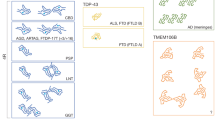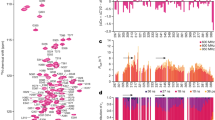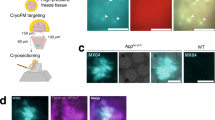Abstract
Alzheimer’s disease is the most common neurodegenerative disease, and there are no mechanism-based therapies. The disease is defined by the presence of abundant neurofibrillary lesions and neuritic plaques in the cerebral cortex. Neurofibrillary lesions comprise paired helical and straight tau filaments, whereas tau filaments with different morphologies characterize other neurodegenerative diseases. No high-resolution structures of tau filaments are available. Here we present cryo-electron microscopy (cryo-EM) maps at 3.4–3.5 Å resolution and corresponding atomic models of paired helical and straight filaments from the brain of an individual with Alzheimer’s disease. Filament cores are made of two identical protofilaments comprising residues 306–378 of tau protein, which adopt a combined cross-β/β-helix structure and define the seed for tau aggregation. Paired helical and straight filaments differ in their inter-protofilament packing, showing that they are ultrastructural polymorphs. These findings demonstrate that cryo-EM allows atomic characterization of amyloid filaments from patient-derived material, and pave the way for investigation of a range of neurodegenerative diseases.
This is a preview of subscription content, access via your institution
Access options
Access Nature and 54 other Nature Portfolio journals
Get Nature+, our best-value online-access subscription
$29.99 / 30 days
cancel any time
Subscribe to this journal
Receive 51 print issues and online access
$199.00 per year
only $3.90 per issue
Buy this article
- Purchase on Springer Link
- Instant access to full article PDF
Prices may be subject to local taxes which are calculated during checkout





Similar content being viewed by others
References
Wilcock, G. K. & Esiri, M. M. Plaques, tangles and dementia. A quantitative study. J. Neurol. Sci. 56, 343–356 (1982)
Ghetti, B. et al. Frontotemporal dementia caused by microtubule-associated protein tau gene (MAPT) mutations: a chameleon for neuropathology and neuroimaging. Neuropathol. Appl. Neurobiol. 41, 24–46 (2015)
Kidd, M. Paired helical filaments in electron microscopy of Alzheimer’s disease. Nature 197, 192–193 (1963)
Terry, R. D. The fine structure of neurofibrillary tangles in Alzheimer’s disease. J. Neuropathol. Exp. Neurol. 22, 629–642 (1963)
Yagishita, S., Itoh, Y., Nan, W. & Amano, N. Reappraisal of the fine structure of Alzheimer’s neurofibrillary tangles. Acta Neuropathol. 54, 239–246 (1981)
Crowther, R. A. Straight and paired helical filaments in Alzheimer disease have a common structural unit. Proc. Natl Acad. Sci. USA 88, 2288–2292 (1991)
Wischik, C. M. et al. Structural characterization of the core of the paired helical filament of Alzheimer disease. Proc. Natl Acad. Sci. USA 85, 4884–4888 (1988)
Berriman, J. et al. Tau filaments from human brain and from in vitro assembly of recombinant protein show cross-β structure. Proc. Natl Acad. Sci. USA 100, 9034–9038 (2003)
Braak, H. & Del Tredici, K. Potential pathways of abnormal Tau and α-synuclein dissemination in sporadic Alzheimer’s and Parkinson’s diseases. Cold Spring Harb. Perspect. Biol. 8, a023630 (2016)
Jackson, S. J. et al. Short fibrils constitute the major species of seed-competent Tau in the brains of mice transgenic for human P301S Tau. J. Neurosci. 36, 762–772 (2016)
Goedert, M., Spillantini, M. G., Jakes, R., Rutherford, D. & Crowther, R. A. Multiple isoforms of human microtubule-associated protein tau: sequences and localization in neurofibrillary tangles of Alzheimer’s disease. Neuron 3, 519–526 (1989)
Crowther, R. A. & Goedert, M. Abnormal tau-containing filaments in neurodegenerative diseases. J. Struct. Biol. 130, 271–279 (2000)
Guo, J. L. et al. Unique pathological tau conformers from Alzheimer’s brains transmit tau pathology in nontransgenic mice. J. Exp. Med. 213, 2635–2654 (2016)
Schmidt, M. et al. Peptide dimer structure in an Aβ(1–42) fibril visualized with cryo-EM. Proc. Natl Acad. Sci. USA 112, 11858–11863 (2015)
Colvin, M. T. et al. Atomic resolution structure of monomorphic Aβ42 amyloid fibrils. J. Am. Chem. Soc. 138, 9663–9674 (2016)
Lu, J.-X. et al. Molecular structure of β-amyloid fibrils in Alzheimer’s disease brain tissue. Cell 154, 1257–1268 (2013)
Wälti, M. A. et al. Atomic-resolution structure of a disease-relevant Aβ(1–42) amyloid fibril. Proc. Natl Acad. Sci. USA 113, E4976–E4984 (2016)
Tuttle, M. D. et al. Solid-state NMR structure of a pathogenic fibril of full-length human α-synuclein. Nat. Struct. Mol. Biol. 23, 409–415 (2016)
Goedert, M., Spillantini, M. G., Cairns, N. J. & Crowther, R. A. Tau proteins of Alzheimer paired helical filaments: abnormal phosphorylation of all six brain isoforms. Neuron 8, 159–168 (1992)
McEwan, W. A. et al. Cytosolic Fc receptor TRIM21 inhibits seeded tau aggregation. Proc. Natl Acad. Sci. USA 114, 574–579 (2017)
He, S. & Scheres, S. H. W. Helical reconstruction in RELION. J. Struct. Biol. 198, 163–176 (2017)
Fitzpatrick, A. W. P. et al. Atomic structure and hierarchical assembly of a cross-β amyloid fibril. Proc. Natl Acad. Sci. USA 110, 5468–5473 (2013)
Jakes, R., Novak, M., Davison, M. & Wischik, C. M. Identification of 3- and 4-repeat tau isoforms within the PHF in Alzheimer’s disease. EMBO J. 10, 2725–2729 (1991)
Wischik, C. M. et al. Isolation of a fragment of tau derived from the core of the paired helical filament of Alzheimer disease. Proc. Natl Acad. Sci. USA 85, 4506–4510 (1988)
Taniguchi-Watanabe, S. et al. Biochemical classification of tauopathies by immunoblot, protein sequence and mass spectrometric analyses of sarkosyl-insoluble and trypsin-resistant tau. Acta Neuropathol. 131, 267–280 (2016)
Dan, A. et al. Extensive deamidation at asparagine residue 279 accounts for weak immunoreactivity of tau with RD4 antibody in Alzheimer’s disease brain. Acta Neuropathol. Commun. 1, 54 (2013)
Crick, F. H. C. & Rich, A. Structure of polyglycine II. Nature 176, 780–781 (1955)
Jicha, G. A., Bowser, R., Kazam, I. G. & Davies, P. Alz-50 and MC-1, a new monoclonal antibody raised to paired helical filaments, recognize conformational epitopes on recombinant tau. J. Neurosci. Res. 48, 128–132 (1997)
Bibow, S. et al. The dynamic structure of filamentous tau. Angew. Chem. Int. Edn Engl. 50, 11520–11524 (2011)
Carmel, G., Mager, E. M., Binder, L. I. & Kuret, J. The structural basis of monoclonal antibody Alz50’s selectivity for Alzheimer’s disease pathology. J. Biol. Chem. 271, 32789–32795 (1996)
Poorkaj, P. et al. An R5L tau mutation in a subject with a progressive supranuclear palsy phenotype. Ann. Neurol. 52, 511–516 (2002)
Hayashi, S. et al. Late-onset frontotemporal dementia with a novel exon 1 (Arg5His) tau gene mutation. Ann. Neurol. 51, 525–530 (2002)
Clavaguera, F. et al. Brain homogenates from human tauopathies induce tau inclusions in mouse brain. Proc. Natl Acad. Sci. USA 110, 9535–9540 (2013)
Sunde, M. et al. Common core structure of amyloid fibrils by synchrotron X-ray diffraction. J. Mol. Biol. 273, 729–739 (1997)
Govaerts, C., Wille, H., Prusiner, S. B. & Cohen, F. E. Evidence for assembly of prions with left-handed b-helices into trimers. Proc. Natl Acad. Sci. USA 101, 8342–8347 (2004)
Kadavath, H. et al. Folding of the Tau protein on microtubules. Angew. Chem. Int. Edn Engl. 54, 10347–10351 (2015)
Chiti, F. & Dobson, C. M. Protein misfolding, functional amyloid, and human disease. Annu. Rev. Biochem. 75, 333–366 (2006)
von Bergen, M. et al. Assembly of t protein into Alzheimer paired helical filaments depends on a local sequence motif (306VQIVYK311) forming b structure. Proc. Natl Acad. Sci. USA 97, 5129–5134 (2000)
Xie, C. et al. Identification of key amino acids responsible for the distinct aggregation properties of microtubule-associated protein 2 and tau. J. Neurochem. 135, 19–26 (2015)
Sawaya, M. R. et al. Atomic structures of amyloid cross-b spines reveal varied steric zippers. Nature 447, 453–457 (2007)
Gustke, N., Trinczek, B., Biernat, J., Mandelkow, E. M. & Mandelkow, E. Domains of tau protein and interactions with microtubules. Biochemistry 33, 9511–9522 (1994)
Kaufman, S. K. et al. Tau prion strains dictate patterns of cell pathology, progression rate, and regional vulnerability in vivo. Neuron 92, 796–812 (2016)
Kajava, A. V. & Steven, A. C. b-rolls, b-helices, and other b-solenoid proteins. Adv. Protein Chem. 73, 55–96 (2006)
Wasmer, C. et al. Amyloid fibrils of the HET-s(218–289) prion form a b solenoid with a triangular hydrophobic core. Science 319, 1523–1526 (2008)
Riek, R. & Eisenberg, D. S. The activities of amyloids from a structural perspective. Nature 539, 227–235 (2016)
Herrmann, U. S. et al. Structure-based drug design identifies polythiophenes as antiprion compounds. Sci. Transl. Med. 7, 299ra123 (2015)
Åslund, A. et al. Novel pentameric thiophene derivatives for in vitro and in vivo optical imaging of a plethora of protein aggregates in cerebral amyloidoses. ACS Chem. Biol. 4, 673–684 (2009)
Kolb, H. C. & Andrés, J. I. Tau positron emission tomography imaging. Cold Spring Harb. Perspect. Biol. 9, a023721 (2017)
Spina, S. et al. The tauopathy associated with mutation +3 in intron 10 of Tau: characterization of the MSTD family. Brain 131, 72–89 (2008)
Falcon, B. et al. Conformation determines the seeding potencies of native and recombinant Tau aggregates. J. Biol. Chem. 290, 1049–1065 (2015)
Zheng, S. Q. et al. MotionCor2: anisotropic correction of beam-induced motion for improved cryo-electron microscopy. Nat. Methods 14, 331–332 (2017)
Zhang, K. Gctf: Real-time CTF determination and correction. J. Struct. Biol. 193, 1–12 (2016)
Chen, S. et al. High-resolution noise substitution to measure overfitting and validate resolution in 3D structure determination by single particle electron cryomicroscopy. Ultramicroscopy 135, 24–35 (2013)
Emsley, P., Lohkamp, B., Scott, W. G. & Cowtan, K. Features and development of Coot. Acta Crystallogr. D Biol. Crystallogr. 66, 486–501 (2010)
Murshudov, G. N., Vagin, A. A. & Dodson, E. J. Refinement of macromolecular structures by the maximum-likelihood method. Acta Crystallogr. D Biol. Crystallogr. 53, 240–255 (1997)
Iverson, T. M., Alber, B. E., Kisker, C., Ferry, J. G. & Rees, D. C. A closer look at the active site of γ-class carbonic anhydrases: high-resolution crystallographic studies of the carbonic anhydrase from Methanosarcina thermophila. Biochemistry 39, 9222–9231 (2000)
Chen, V. B. et al. MolProbity: all-atom structure validation for macromolecular crystallography. Acta Crystallogr. D Biol. Crystallogr. 66, 12–21 (2010)
Acknowledgements
These findings mark the culmination of a conversation at the MRC Laboratory of Molecular Biology 34 years ago between A. Klug, the late M. Roth and R.A.C. about the structural analysis of Alzheimer filaments. We thank the patient’s family for donating brain tissue; M. R. Farlow for clinical evaluation; F. Epperson, R. M. Richardson and U. Kuederli for human brain collection and analysis; P. Davies, M. Hasegawa and M. Novak for antibodies MC-1, TauC4 and MN423, respectively; H. Zhou for use of the Titan Krios at UCLA EICN; S. Chen, C. Savva and G. Cannone for support with electron microscopy at the MRC Laboratory of Molecular Biology; T. Darling and J. Grimmett for help with computing; and M. Skehel for support with mass spectrometry. M.G. is an Honorary Professor in the Department of Clinical Neurosciences of the University of Cambridge. This work was supported by the UK Medical Research Council (MC_UP_A025_1012 to G.M., MC_U105184291 to M.G. and MC_UP_A025_1013 to S.H.W.S.), the European Union (Marie Curie International Outgoing Fellowship to A.W.P.F., Joint Programme-Neurodegeneration Research to M.G. and B.F., and Horizon 2020 IMPRiND to M.G. and A.W.P.F.), the US National Institutes of Health (grant P30-AG010133 to B.G.) and the Department of Pathology and Laboratory Medicine, Indiana University School of Medicine (to B.G.).
Author information
Authors and Affiliations
Contributions
B.G. performed neuropathology; H.J.G. performed genetic analysis; B.F. conducted filament extraction and immunolabelling; A.W.P.F. performed cryo-EM; S.H. and S.H.W.S. provided cryo-EM software; A.W.P.F. and S.H.W.S. analysed cryo-EM data; A.W.P.F., A.G.M. and G.M. built the atomic model; R.A.C. contributed to the inception of the study; M.G. and S.H.W.S. supervised the project; all authors contributed to writing the manuscript.
Corresponding authors
Ethics declarations
Competing interests
The authors declare no competing financial interests.
Additional information
Reviewer Information Nature thanks E. Egelman, D. Eisenberg and B. Meier for their contribution to the peer review of this work.
Publisher's note: Springer Nature remains neutral with regard to jurisdictional claims in published maps and institutional affiliations.
Extended data figures and tables
Extended Data Figure 1 Immunolabelling of the brain sample.
a, b, Immunolabelling of the sarkosyl-insoluble fraction from the patient’s temporal cortex. a, Immunoblots using anti-tau antibodies BR133 (N terminus), BR135 (R3), TauC4 (R4), BR134 (C terminus), AT8 (pS202/pT205) and MC-1. b, Immunogold negative-stain electron microscopy of PHFs and SFs with BR133, BR135, TauC4, BR134, AT8 and MC-1. Scale bar, 500 Å. c, Light microscopy of sections from the temporal cortex showing staining of neurofibrillary tangles, neuropil threads and plaque neurites using RD3 (3R), anti-4R (4R), AT8 and AT100 (pT212/pS214/pT217). Nuclei are counterstained blue. Scale bar, 50 μm.
Extended Data Figure 2 PHFs and SFs at various stages during purification.
a–c, Cryo-EM micrographs and reference-free 2D class averages for PHFs (blue insets) and SFs (green insets) for the tau sample after the sucrose step (a), gel filtration (b), and pronase treatment (c). Examples of PHFs and SFs in the micrographs are indicated with blue and green arrowheads, respectively. Scale bars, 500 Å. d, Western blots with antibody HT7 (Thermo; catalogue nr. MN1000) of the total lysate, sarkosyl-soluble and sarkosyl-insoluble fractions of HEK 293T cells expressing wild-type 0N4R human tau and treated with (+) or without (−) the sarkosyl-insoluble fraction from the patient’s temporal cortex following gel filtration show that the cryo-EM sample is capable of seeding aggregation of human tau. e, Densitometric analysis (mean ± s.e.m., n = 3) of HT7 blots of sarkosyl-insoluble fractions from cells.
Extended Data Figure 3 Cryo-EM map and model comparisons.
a, Fourier shell correlation (FSC) curves between two independently refined half-maps for the full-length (FL) PHFs (blue, solid); FL SFs (green, solid); pronase-treated (PT) PHFs (blue, dashed) and PT SFs (green, dashed). b, FSC curves between the cryo-EM reconstructions and the refined atomic models, using the same colour coding as in a. c, Local resolution estimates for the four cryo-EM reconstructions. d, Comparison of power spectra (the squared amplitudes of the Fourier transform, FT) of reference-free 2D class averages with those of corresponding projections of the atomic models. In PHFs the approximate 21 screw symmetry between subunits on the two protofilaments leads to off-meridional n = 1 Bessel function peaks on the 1/(4.7 Å) layer line (blue arrows). For SFs, in which the asymmetric unit consists of two subunits at the same level, one from each protofilament, there is a meridional n = 0 Bessel function peak on the 1/(4.7 Å) layer line (green arrows).
Extended Data Figure 4 Close-up views of cryo-EM map and models.
The R3–R4 model provides the best fit to cryo-EM densities in the β-helix region (top row) and the cross-β region near the termini (second row) of the PHF protofilaments. The same model also provides the best fit to densities at the cross-β regions near the termini of the two protofilaments (third and fourth row) in SFs. Major discrepancies between the cryo-EM density and alternative atomic models (consisting of R2–R3, R1–R3 and R1–R2 cores) are highlighted with red dashed outlines.
Extended Data Figure 5 Comparison of PHF and SF protofilament cores.
a, The PHF backbone atoms are shown in blue and the SF backbone atoms in green. The r.m.s.d. between the backbone atoms is 1.2 Å. b, As in a, but showing all atoms.
Extended Data Figure 6 Cross-sections of the pronase-treated PHF and SF cryo-EM structures.
Sharpened maps are shown in blue for PHFs (a) and green for SFs (b). Additional densities in contact with lysines 317 and 321 are indicated with red arrows. Unsharpened density, lowpass filtered to 4.5 Å resolution for the PHFs, is shown in grey. The unsharpened density that is highlighted with an orange background is reminiscent of a less ordered β-sheet and could accommodate an additional 16 amino acids, which would correspond to a mixture of residues 259–274 (R1) from 3R tau and residues 290–305 (R2) from 4R tau.
Extended Data Figure 7 Mass-spectrometry and antibody labelling support the model of an R3–R4 core.
a, Relative abundance of identified peptides from the pronase-treated filaments by mass spectrometry (shown in green). The peptide used to produce anti-4R tau is shown in blue (with a D instead of an N at position 279). The epitope of MN423 is shown in orange. b, Immunogold negative-stain electron microscopy of PHFs and SFs with anti-4R tau (top) and MN423 (bottom) with (+) and without (−) pronase treatment. Scale bar, 100 nm.
Extended Data Figure 8 Comparison of the tau β-helix with the HET-s β-helices.
a, Overlay of the backbones of the β-helix in tau (cyan) and the HET-s β-helices (orange and purple). The r.m.s.d. between the backbone atoms is 1.3 Å. b, c, All-atom overlays of the tau and HET-s β-helices.
Extended Data Figure 9 Hypothetical core structures.
Schematic views of hypothetical core structures of R1–R3 from 3R tau (a), R2–R3 from 4R tau (b) and R1–R2 from 4R tau (c). Note that in these conformations, the β-helices would only be 18 instead of 19 residues long, because of an additional residue (D348) in R4. Still, the β-helices would have mainly hydrophobic residues in the core, polar residues on the outside, and the pivotal glycine closing the motif. Each hypothetical core structure also contains the first 10 amino acids of the next repeat (R4 for R1–3 and R2–R3; R3 for R1–R2). It could also be that there are cores made of three or more repeats.
Rights and permissions
About this article
Cite this article
Fitzpatrick, A., Falcon, B., He, S. et al. Cryo-EM structures of tau filaments from Alzheimer’s disease. Nature 547, 185–190 (2017). https://doi.org/10.1038/nature23002
Received:
Accepted:
Published:
Issue Date:
DOI: https://doi.org/10.1038/nature23002
This article is cited by
-
Misfolded protein oligomers: mechanisms of formation, cytotoxic effects, and pharmacological approaches against protein misfolding diseases
Molecular Neurodegeneration (2024)
-
Astrocytic accumulation of tau fibrils isolated from Alzheimer’s disease brains induces inflammation, cell-to-cell propagation and neuronal impairment
Acta Neuropathologica Communications (2024)
-
Overlaps and divergences between tauopathies and synucleinopathies: a duet of neurodegeneration
Translational Neurodegeneration (2024)
-
Local structural preferences in shaping tau amyloid polymorphism
Nature Communications (2024)
-
Cryo-EM structures of amyloid-β and tau filaments in Down syndrome
Nature Structural & Molecular Biology (2024)
Comments
By submitting a comment you agree to abide by our Terms and Community Guidelines. If you find something abusive or that does not comply with our terms or guidelines please flag it as inappropriate.



